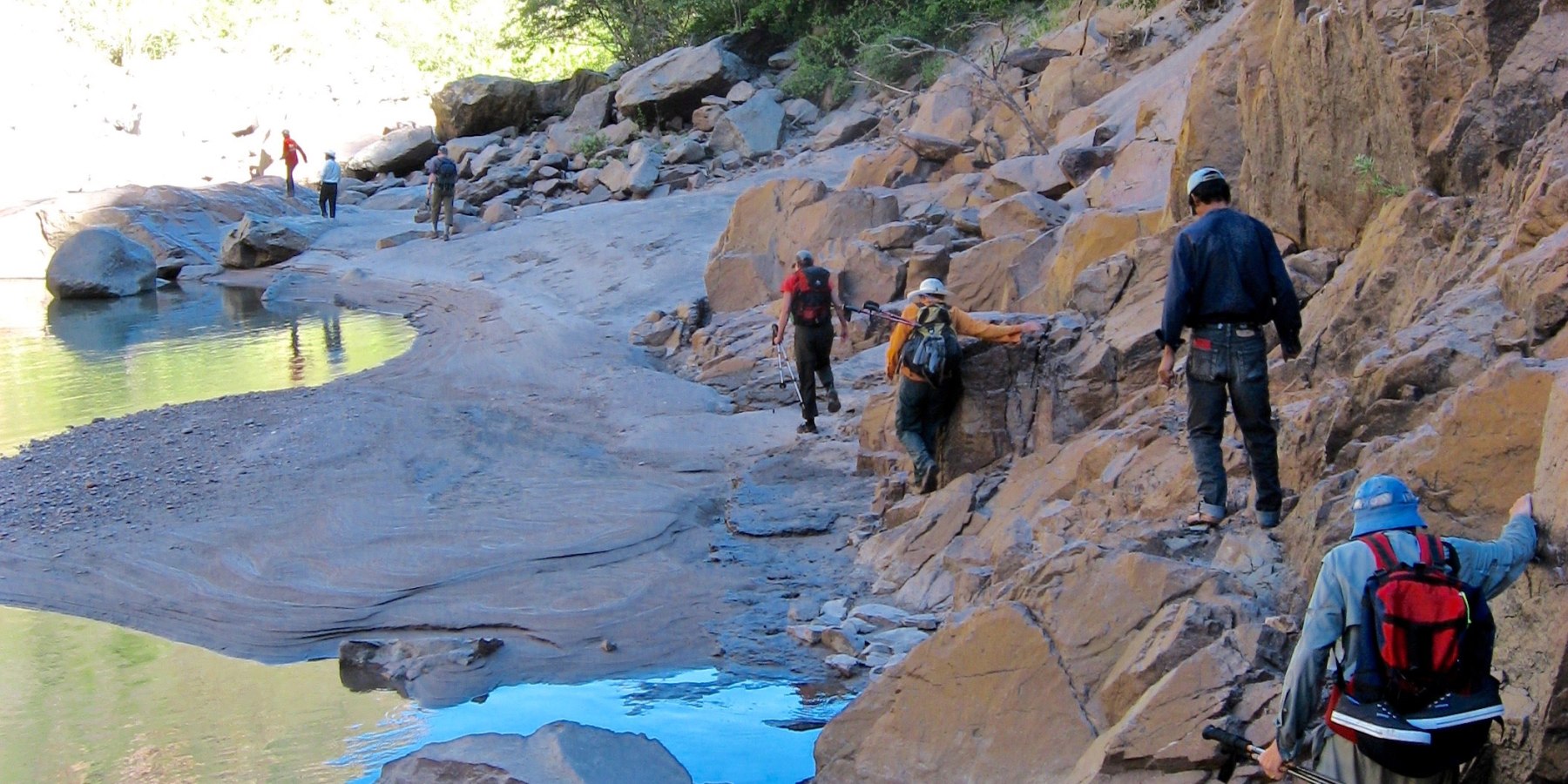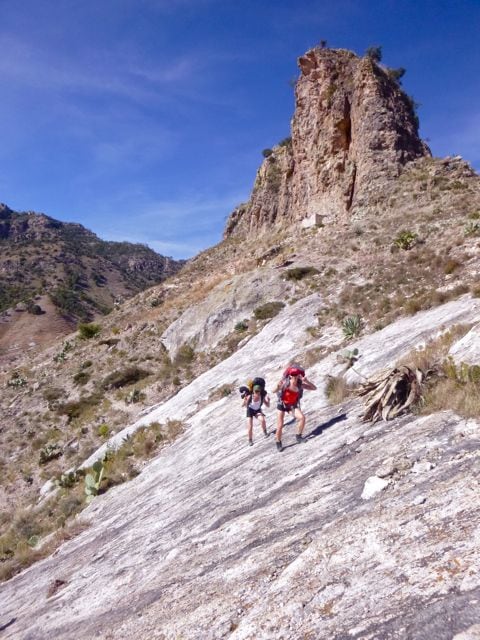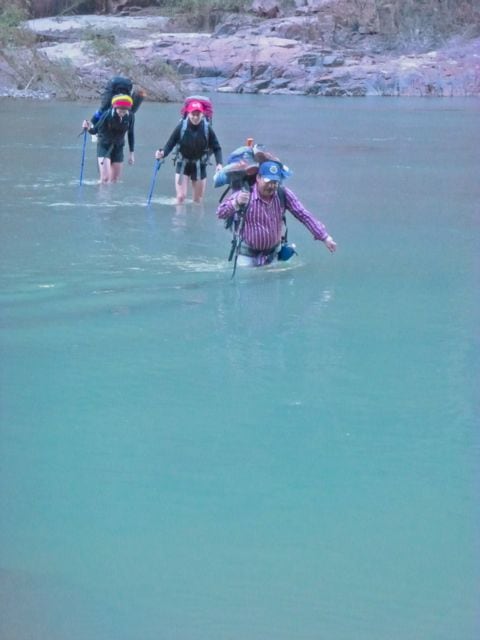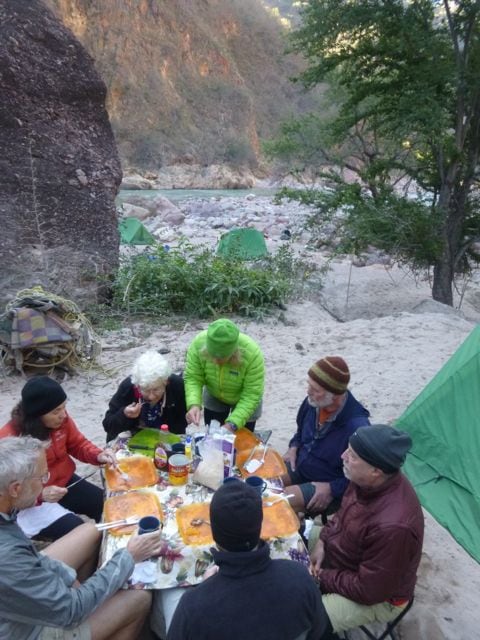
December 12: Dia de la Virgin de Guadalupe
The week preceding la Dia de la Virgin brought four days of rain, and promised more. Celebrations in Creel sounded like the Blessing of the Fleet. Big trucks from lumber, mining, construction, tourism, and ranching converged in a cacaphony of horns, sirens, and bands playing Mañanitas on their flatbeds. [YouTube Link] They made a loop of the main square and stopped in front of the church where at the end of festivities the Bier of the Virgin was carried inside. The festivities on the canyon rim in Areponapuchi were a bit less garish, but a bit more boisterous. In the mud and fog and rain, the vendors set up with piping hot champorada (hot chocolate) and ollas of tamales, with cerveza clandestina hovering ever present. The four piece band for the second night in a row set up under the tiny new ramada beside the church. One couple was celebrating their 25th wedding anniversary. The rain crowded closer and made for a convivial evening of dancing. Back at our room at Maria’s “el Castillo”, the fog was so thick we couldn’t even see the lights of the next hotel barely 50 meters away. We were starting an ambitious backpack the following morning, and dreading the possibilities.
Gracias a Dios, the following morning dawned bright and clear, but the whole course of the Rio Urique and its major drainages were blanketed in thick fog. Questions arose that morning as our group of four planned to start a 4-day 35-mile Rim-to-Rim-to-Rim hike. Questions loomed! Would we even be able to cross the Urique after so much rain? Was the clear morning just a break between rain fronts? Would the mud and runoff turn the hike into a muddy slog, or worse yet, would it turn the descent into a slippery slide that we would just have to claw our way up from the next day when we couldn’t go upstream, downstream, or across? Would the winter days be long enough to reach our daily goals? We planned as best as we could, and contentedly oblivious set off down the trail. Frozen mud in the cold corners of the winding trail at 2200 meters was better footing than the sun warmed oozing muck. We lost elevation quickly as the day warmed up and forgot our worries. We caught lunch at a spot that shaded over midway through, and were reminded how low the sun stays on short winter days and how quickly it gets cold. We made the river just as sunset glowed on the highest spires we could see of the canyon rim, and with the morning fog lifted we didn’t like the look of the river. On day one of this hike, it’s a great idea to end the day fording the river and warming up beside a driftwood fire, instead of starting the day with cold muscles and a dreaded cold water crossing. In this case, I guess it worked out for the best. We had passed the shallowest ford in search of a decent campsite, but overnight the river dropped 5 cm.
The deepest point of the shallow crossing we scouted that morning was above the belt, but thankfully in slow moving water. Yhheeee! Shrinkage aside, it was thankfully uneventful, but it took a precious bit of time to get wet stuff put away and changed over to our hiking gear. And with only 1500 meters of climb ahead of us, we started up. A mere 9 hours later, hot and sweaty, and cold and hungry, we arrived at the Misión Pamachi. We had to buy firewood and drinking water from the missionary, and in the shadow of the church under a full moon, we started dinner. The wind picked up and howled. I think we all had a restless night as the relentless wind rattled the tent with a vengance, metal roofs nearby flapped angrily, the village dogs howled at the moon, and an errant pig came around grunting and prowling for scraps.
In the morning, the strong, fresh-ground coffee strained through a sock* (*not a true sock) was invigorating, the breakfast of granola and locally sourced pinole was fortifying, and we started on our way. Having a strong group on a fast paced hike like this is essential, and everyone was onboard. We had a great traverse of the undulating treeless volcanic mesa with splendid views of the far canyon rim, and the hotels and train station where we had recently started. A rare pictograph panel of recent vintage sported houses with peaked roofs just before a huge pile of rocks informed us we were at a trail junction. Known as a mohonera, this cairn was indicative of a superstition held by the indigenous Tarahumar that a restless spirit from one valley could not traverse past the cairn to the adjacent valley. We added a rock per tradition, and then dropped into the abyss of the camino real for the steep descent back to the river. Mimicking our local guide’s easy step on the loose gravel, we found ourselves enjoying the descent without the accompanying “jelly knee” and “wooden leg” that makes the Sierra Madre trails so infamous. In the New York Times’ bestseller “Born to Run”, the author describes Caballo Blanco’s succinct division of the rocks on the Tarahumara trails into categories of helpers; or hurters- the dreaded cingaderos. Losing 1500 meters in 4 miles, you have to employ some tricks. We had to be constantly crouched, using our already inflamed knees like shock absorbers. Yes, we had an indispensable friend in ibuprofen. We were kind of running or more likely shuffling, striking toes first, to keep our heels from slipping up, and looking desperately for those helper rocks to use as breaks. And we kept our feet a bit splayed to scoop the gravel. Walking in the conventional sense was impossible. We were in a state of controlled skidding and sliding for 4 hours, not counting breaks. We arrived at the river to the sound of braying donkeys laughing at our awkward gait with time enough to scout a good ford, bathe, and set up camp well before sunset. Safely across the river, it was time to relax. We broke out a flask to toast Mexico’s indigenous saint for her blessing, and to enjoy the golden glow on the cliffs high above.
This hike is described in the January, 2009, issue of Backpacker magazine as a 5-day hike, and taking your time is strongly recommended. Happy Trails




